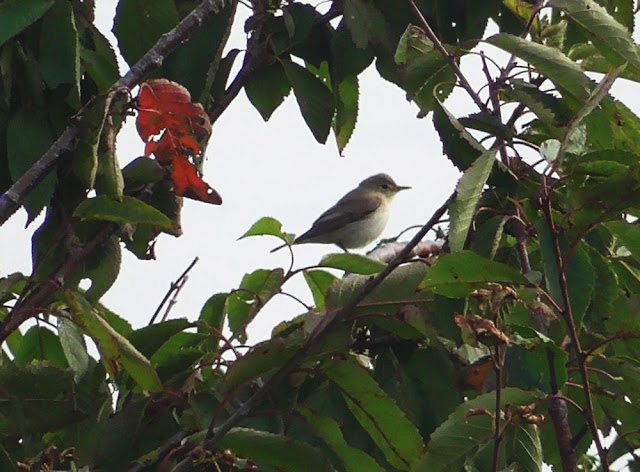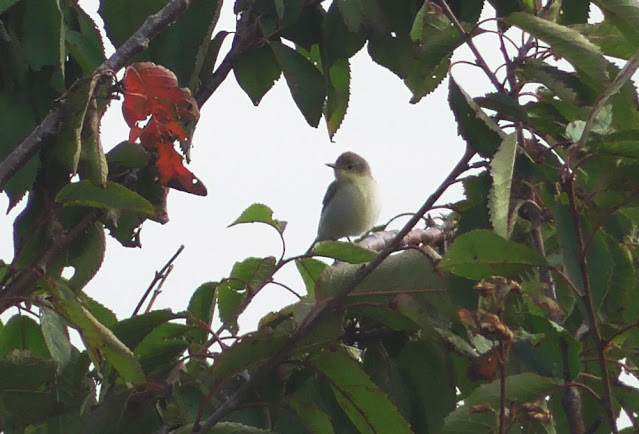Well I was quite content with my couple of hours of birding in my Patchwork Challenge patch this morning...
I'd seen good numbers of warblers on Seaton Marshes, along with several Yellow Wagtails and three Kingfishers. And on Colyford Marsh, having missed three less than one-day birds this year, finally Marsh Harrier made it on to my Patchwork Challenge list...
 |
| Think this photo just about rules out Golden Eagle? |
But then, just before 08:30, for the first time this year I had to abandon my Patchwork Challenge patch and twitch Beer Head as Kev had found a patch first - of one flavour or another...
Kev had stumbled upon a hippolais warbler, either an Icterine or Melodious, luckily for me who didn't have much time, in a large area of scrub not all the far from where we park. Twenty minutes later I was there, but as I walked to join the trio of birders who had seen it, they reported they had last seen it fly out of the isolated scrub patch it was in and towards Beer Head Caravan Park. I immediately felt like I was in a dipping scenario.
I was wrong. A few Willow Warblers appeared right beside me, and soon after Clive turned up, out emerged a plain looking face - followed by a bloody Icterine Warbler!!!
I say 'bloody' as this was NOT expected! Far rarer than Melodious down here, and we are on a stretch of coast that in late August during southerly winds you'd almost describe as optimum for this Mediterranean species - but we are yet to record one.
I had two clear and decent bin views of it, then for the third time it showed I fired up my camcorder. At the end of this very short bit of film, it jumps out to the left of frame and very sadly was never seen again. Here is the vid...
Note the tail-dipping, almost flycatcher-like behaviour and even the fact it is at the top of a tree! All good Icky behavioural traits.
And here's a couple of stills from this video, quite pleased how they have come out...
 |
| Such a prominent almost solid pale wing panel |
 |
| The yellow on this bird was restricted to its throat and face, with maybe a touch on its breast |
 |
| Tail down and head up |
 |
| A tail-pump in action! |
And now for a proper photo of it! Taken by finder Kev, thanks for the great find Kev...
 |
| What a pic of a patch first! And of a warbler - better than any warbler photo I have EVER taken! |
Kev's photos show so many of the good pro Icky ID pointers. The steely blue legs, really long bill and pale wing panels can be shown by Melodious, although all three would be unusual I guess. However those lovely pale edged/tipped greater coverts, tertials and primaries, as well as the long primary projection are solid Icky features.
Then there was how it looked and behaved in the field. I have always found Melodious to be a bit Garden Warbler-like. Fat and lazy. And rounded, with round heads and blunter more rounded wing tips. Whereas, just like this bird, Icterines look a bit un warbler-like, almost Flycatchery, and just very pointy with long wing-tips and a long bill.
Additionally, although I don't at all think this is proven it's just something I have found in the past, I find Melodious tend to show more of that 'open face look' that you expect from a hippo, whereas Ickys display darker ear coverts and sometimes a more noticeable supercillium, so giving slightly less of that 'open face' appearance.
So, that was that. Field birders happy with ID, others on local and county Whatsapp groups happy with ID (including a wonderful annotated copy of Kevs photo by Mike Langman). But then this comes out on BirdGuides...
 |
| Oh, really!? |
This took me right back to the Beer Head Blyth's Reed Warbler that Kev also found back in 2020.
That was reidentified as a Marsh Warbler on BirdGuides whilst all onsite birders were well down the Blyth's Reed route... It did then slow down its song during the afternoon so it is a good job a tiny winged dark brown acro appeared hoping around the bottom of the bush at the end of the day otherwise the doubt probably would have been the death of that record (the full tale can be read about on THIS blog post).
So, with some doubt added to the mix today, although many were well on the Icterine side of the fence, I knew I had to ask a man who has seen and handled a lot more Melodies and Ickys than me. I hope Martin Cade doesn't mind me copying some of the contents of his response on here...
"This is an Icterine: the secondary panel is way too white and conspicuous for a Melodious, the primary projection is long, the primaries are strongly tipped pale, the tertials are very clean-edged and dark centred, the greater coverts have decent pale edges and tips and, on the video, it dips its tail quite conspicuously. For me this all equals a certain Icterine.
I’m usually ultra-conservative but for me there’s no doubt about this one – wouldn’t it be funny if new evidence emerges that completely refutes all I’ve just written!!
Hope that’s useful and doesn’t put a cat amongst the pigeons if everyone’s decided it’s a Melodious".
As you can see from the last line, I did not include in my email what I thought it was or what the field views suggested.
Thank you again Kevin, just reward for your continued perseverance with this site. Am just sorry that more didn't connect with it - I consider myself extremely lucky to have arrived just in the nick of time.




















